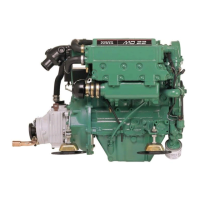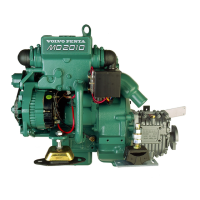33
33. Broken drive on fuel injection pump.
34. Timing of fuel injection pump is incorrect.
35. Tappet clearances are incorrect.
36. Valve timing is incorrect.
37. Bad compression.
38. Cylinder head gasket leaks.
39. Valves are not free.
40. Wrong high-pressure pipes.
41. Worn cylinder bores.
42. Leakage between valves and seats.
43. Piston rings are not free or they are worn or
broken.
44. Valve stems and/or guides are worn.
45. Crankshaft bearings are worn or damaged.
46. Lubricating oil pump is worn.
47. Relief valve does not close.
48. Relief valve does not open.
49. Relief valve spring is broken.
50. Fault in suction pipe of lubricating oil pump.
51. Piston is damaged.
52. Piston height is incorrect.
53. Flywheel housing or flywheel is not aligned correctly.
54. Fault in thermostat or thermostat is of an incorrect
type.
55. Restriction in coolant passages.
56. Fault in water pump.
57. Valve stem seal is damaged.
58. Restriction in sump strainer.
59. Valve spring is broken.
Emergency procedures
If the engine stops
1. Check that the fuel supply control (if fitted) is in the
open position.
2. Check the amount of fuel in tank. If the engine has
run until the tank is empty, there can be dirt or air
in the fuel pipes. Change the fuel filter, fill the tank,
eliminate air from the system and start the engine
again. If the engine still will not start, disconnect
the electrical stop solenoid of the fuel injection
pump and start the engine. The mechanical stop
lever of the pump can be used to stop the engine.
If there is a reduction in engine speed or a loss of
power
1. Check that the propeller is free of debris, etc.
2. Check that the induction system is not restricted
and that the engine compartment has a good
supply of air.
If the engine coolant is at boiling point
1. Reduce the engine speed.
2. Check the seacock and strainer to ensure that
there is a good supply of water to the cooling
system.
3. Check the raw water pump operation for impeller
failure, check for coolant leakage.
4. Check for air in the fresch water system, slipping
or broken drive belt for the circulation pump,
blocked heat exchanger, faulty thermostat or faulty
instrument or sender.
Normally, coolant leakage can be stopped temporarily
with adhesive tape, hose and hose clips.
If a bad leakage occurs from a high pressure fuel
pipe
Disconnect the pipe, let the fuel flow into a container
and operate the engine at a reduced speed on the
remainder of the cylinders.
If leakage occurs from a low pressure fuel pipe
Temporarily stop the leak with adhesive tape, hose
and hose clips.
If a bad lubricating oil leakage occurs
1. Stop the engine immediately and try to find the
cause.
2. If the main flow can be reduced, put a suitable
container under the leakage point.
3. Fill the engine with new lubricating oil at the same
rate as the less of oil and frequently check the
lubricating oil pressure.

